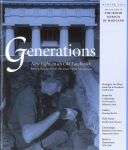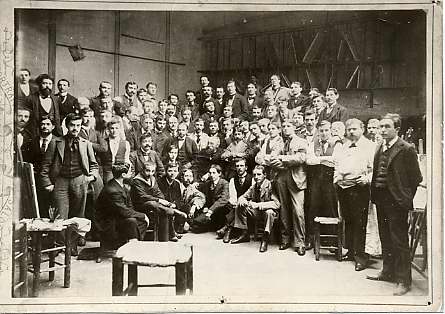An Artist’s Education

 Part 3 of “Saul Bernstein: Baltimore Artist,” written by Jobi Okin Zink, former JMM collections manager. Originally published in Generations – Winter 2001.
Part 3 of “Saul Bernstein: Baltimore Artist,” written by Jobi Okin Zink, former JMM collections manager. Originally published in Generations – Winter 2001.
Bernstein completed the four-year course of study at Maryland Institute in eighteen months and then studied briefly at the Metropolitan School of Fine Art in New York. He wanted to become “the first great Zionist artist” and create propaganda for the Zionist movement, but first he sought additional training. The great studios of Paris beckoned to him. Otto Fuchs, one of Bernstein’s professors at the Maryland Institute, persuaded Mendes Cohen, a wealthy Baltimorean and president of the Maryland Historical Society, contribute $50 toward Bernstein’s trip abroad. Henrietta Szold, whom Bernstein knew through his involvement in the Baltimore Zionist Association, helped to sell his works to raise additional funds. Szold also suggested to New York financier and philanthropist Jacob Schiff that he donate money to support Bernstein’s studies abroad.

In September 1897 Bernstein began two years of study at the Academie Julian, one of the leading art institutes in Paris. Confident in his use of color, he took sculpture and anatomy classes to improve his figures. As testament to his endeavors, his charcoal drawing, “Sanctification of the Sabbath” was well received at the November 1898 American Art Association exhibition held in Paris. In his 1899 letter to Henrietta Szold, Bernstein wrote:
I was always known despite my little feeble figure, as the great artist. Even artists themselves considered me too high for them to envy me, so I had good friends always ready to do all they could for me to learn and inform me of what it takes to become a real artist.
The tone of Bernstein’s letter is perhaps more self-confident than cocky, as he was very aware that he would not have had the academic and financial opportunities he enjoyed without the generosity of others. His benefactors must have been charmed by Bernstein as well as impressed by his talents, as they continued to offer him support.
Even with help from his patrons, Bernstein led a precarious life. He ate little, and to keep his expenses down, he used himself as a model and frequently reused his canvases. When Bernstein’s friend from the Maryland Institute, Hans Shuler, came to study in Paris, Shuler’s mother found Bernstein nearly starving. It is not entirely surprising that Mrs. Shuler returned to Baltimore to solicit her wealthy friends for additional funds to maintain Bernstein in Europe.
Continue to Part 4: Bernstein’s Style, publishing on June 24, 2019.
